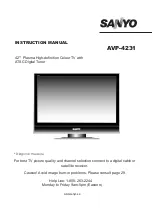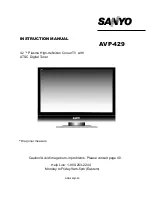
Service Modes, Error Codes, and Fault Finding
5.
this, the TV goes to protection (I
2
C protection). Error code “55”
is logged.
For further diagnoses, you need to overrule the I
2
C protection:
put the TV in Service Default Mode by means of the solder
pads on the SSB (see figure “Service pads”).
The DC/DC converter is still not working because it is switched
“off” by the 3V3_FAULT line (schematic B12). Now you have
some possibilities:
1.
First, measure the impedance over diode 6U06. In normal
conditions, you should measure approximately 120 ohm (if
possible, verify this with another set). If the impedance is
much too low, do not try to start up the converter as
mentioned below. Remind that if FET 7U03 is short-
circuited, this will also influence your measurement.
2.
Desolder coils 5U05 and 5U06, connect an external 3V3
supply at capacitor 2U23 (current limitation to 500 mA) and
a second external 3V3 supply at capacitor 2U31 (current
limitation to 800 mA). The normal working current of the
3V3_SIM line is approximately 400 mA and the normal
working current for the 3V3_DCDCFBX line is
approximately 700 mA. Therefore, if one of the currents
exceeds their nominal value you can determine in which
circuit the overload is situated. If the TV would start up and
you have normal picture, there is probably no overload but
a problem in the detection circuits.
3.
If you do not have two external power supplies, you can do
the following: Desolder coils 5U02, 5U03, and 5U04 (you
must desolder all three, otherwise the circuit could be
damaged), connect an external power supply of 3V3 at the
cathode of diode 6U06. Make sure to limit the current of this
external supply to approximately 1200 mA. If the supplied
current exceeds 1100 mA (approximately normal working
current) you can conclude that one of the devices supplied
by 3V3 is short-circuited.
4.
Another possibility is to force the converter to start up by
short-circuiting (and keep short-circuited) resistor 3U25
(B12).
Caution
: Be aware that this can damage the TV. Even if
you measure approximately 120 ohm over diode 6U06,
there can still be something wrong in the converter itself.
By short-circuiting resistor 3U25, the internal protection of
the converter is disabled.
5.8.4
Protections
Activating SDM via the “service pads” will overrule the
processor-controlled protections, but not the hardware
protections. This means, that the A/D-input protections (5 and
8 V) and the I
2
C “not-acknowledging” info of FBX + EPLD + 3D
Comb and of the tuner are overruled.
Caution
: When doing this, the service technician must know
what he is doing, as it could lead to damaging the TV.
5.8.5
Repair tip table
Table 5-4 Repair tips
Phenomenon
Possible Cause
Repair tip
“F” in right corner of the screen and set is not reacting on
remote control. The local keyboard is functioning.
TV is in factory mode.
Press MENU button on local keyboard for at least 3 seconds. Set will leave
factory mode and function normally again.
No picture, LED blinking at 3 Hz.
Set is in protection due to various causes.
For error codes see error-code list.
You have no picture, so:
- Read the error buffer via ComPair (error buffer is accessible when set is in
protection, ComPair-file will guide you to this).
- Read the blinking LED information via standard remote command
<mute>
06250x
<ok>.
- Or you read the error code sequence via standard remote command
<mute>
062500
<ok>.
When you have found the error, check the circuitry related to the supply voltage
and I
2
C-communication or the circuitry that triggers the protection.
No picture, LED blinking with code 6-6-6 or 18-18-18.
No communication on slow I
2
C- or fast I
2
C-bus. As processor cannot communicate with one of the 2 buses, the Stand-by-LED
spontaneously starts blinking 6-6-6-etc. or 18-18-18-etc...
If in the error buffer somewhere is an error 6 or 18, these will have the highest
priority starting the mentioned blinking.
Measure, dependent of the error on the I
2
C-bus, which device is loading the bus
(use I
2
C-overview).
No picture, LED blinking with code 1-1-1.
No communication on NVM-I
2
C bus to the uP.
As the uP cannot communicate with the NVM I
2
C bus, it spontaneously starts
blinking 1-1-1.
Note:
when there is no access to the NVM, a lot of picture setting
can go wrong.
No RC-reception. Blue LED does not echo RC-
commands.
uP circuitry or RC-receiver is defective.
In case the TV does react on a local keyboard operation, you must check the
RC-receiver circuitry (diagram “J”).
Picture is not synchronised.
The sync is derived in the HIP.
Check crystals in the HIP circuit on bad contacts.
Picture is distorted.
Check video-path in Service Default Mode.
Investigate whether there is an error code present in the error buffer. In case
there is one, check the I
2
C-bus and/or supply lines (see overview supply lines).
Measure and check signal path Tuner-HIP-FBX-EPLD.
Picture with horizontal stripes.
Pixel Plus processing is malfunctioning
Check functionality on circuitry (B3a, B3b, B3c and B3d) of PICNIC, FEM,
EAGLE, COLUMBUS and/or field memories.
Tip:
the whole Pixel Plus chipset
can be diagnosed via ComPair.
No NextView (EPG).
IC7012 defective or not powered.
Check circuitry around IC7012 on diagram “B5a”.
No Teletext.
IC7007 defective or not powered.
Check circuitry around IC7007 on diagram “B5a”.
Problems caused by EPG (Electronic Program Guide).
The TV set "hangs".
Problems with NexTView EPG broadcasts.
To switch from EPG 2C3 to Teletext guide, press for 4 seconds, simultaneously
the MENU button on the TV and digit 0 on the remote. The option settings for
NexTView type and FlashRAM will not change.
NexTView EPG is not functioning only Teletext guide.
EPG version 2C3 is switched “off” during
production.
To switch from Teletext guide to EPG 2C3, press for 4 seconds, simultaneously
the MENU button on the TV and digit 1 on the remote. The option settings for
NexTView type and Flashram will not change.
Various symptoms, due to missing local supply voltage.
An interrupted fuse, NFR-resistor or connection. When no symptom or error code leads you to a specific circuitry, use the supply
lines overview (see supply lines overview), for a quick scan of all supply lines.
No sound at the speakers but sound at monitor out.
Possible problem with the class D amplifier
Check circuitry around IC7700 on diagram “SA3” (LCD) or “C” (PDP).
No sound at the speakers but sound at monitor out.
Sound enable from OTC is HIGH, speakers are
muted
Check pin 95 of OTC on diagram “B5a”.
No sound at the speakers not at monitor out, but sound
at SCART 1 output.
POR line is low, anti plop circuit mutes the sound Check pin 8 on connector 1739 on audio panel. Diagram “C” for PDP sets and
diagram “SA3” for LCD sets
No sound from any output (except headphone)
Reset audio is high or MSP is not properly reset Check pin 16 of MSP (diagram “B6a”) and circuitry around MSP.
No sound from the tuner but sound from any other input. Problem with the delay line (PDP sets only)
Check circuitry on diagram “B6d”.
















































